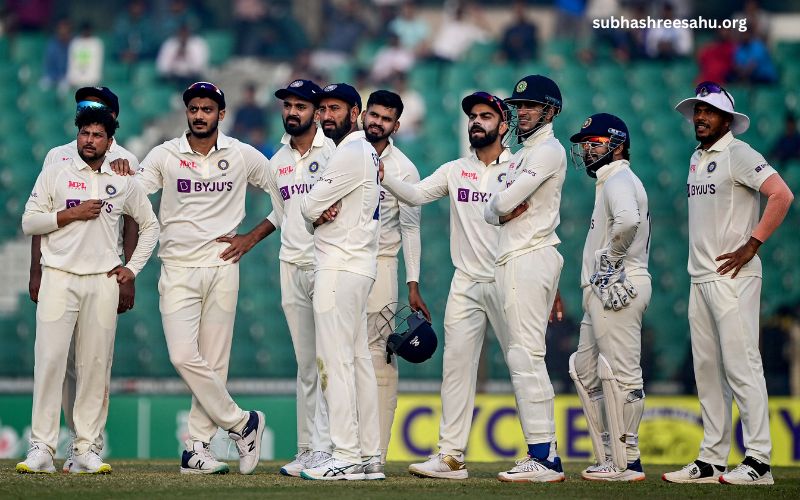In the realm of cricket, the Indian cricket team’s Test jersey holds a significant place. It’s not merely a piece of clothing; rather, it embodies a rich history, cultural pride, and a symbol of excellence on the cricket field. Over the years, the Test jersey has undergone several transformations, reflecting not only changes in fashion but also the evolution of the game and the team’s identity. This article delves into the journey of the Indian cricket team’s Test jersey, exploring its evolution, symbolism, and the impact it has had on players and fans alike.
The Traditional Whites
Traditionally, Test cricket is played in white clothing, a tradition that dates back to the sport’s inception. The Indian cricket team, upon its entry into Test cricket in 1932, adhered to this convention. The whites symbolized purity, simplicity, and a sense of tradition, characteristics deeply ingrained in the sport. For decades, Indian cricketers donned the classic white flannels and sweater vests, proudly representing their nation on the global stage.
The Transition to Colored Clothing
In the 1970s and 80s, a significant shift occurred in cricket attire with the introduction of colored clothing in limited-overs cricket. This change was driven by the need for better visibility for players and spectators, especially under floodlights. However, Test cricket remained untouched by this trend until the late 1990s.
The Indian cricket team, like many others, embraced colored clothing in limited-overs formats but continued to wear whites in Test matches. The white attire symbolized tradition and purity, embodying the essence of Test cricket as the ultimate test of skill, endurance, and character.
The Advent of Team Sponsorship
The late 1990s witnessed another milestone in cricket attire with the advent of team sponsorship. Corporate logos began to appear prominently on players’ jerseys, marking a departure from the traditional plain whites. The Indian cricket team, sponsored by various brands over the years, saw their jerseys adorned with logos of sponsors, adding a commercial dimension to the attire.
While some purists lamented this commercialization, others viewed it as a natural progression in the modernization of the sport. The sponsorship deals not only provided financial support to the teams but also increased the visibility of brands, leveraging the immense popularity of cricket in India and beyond.
Innovation and Identity
As cricket continued to evolve, so did the design of team jerseys. With the advent of advanced fabric technologies and design innovations, cricket jerseys became lighter, more breathable, and tailored for performance. The Indian cricket team’s Test jersey underwent subtle changes, incorporating modern elements while retaining its traditional essence.
One significant development was the introduction of personalized jerseys, featuring players’ names and numbers on the back. This added a personal touch to the attire, fostering a stronger connection between players and fans. Moreover, it facilitated merchandise sales, allowing fans to own replicas of their favorite players’ jerseys.
The Influence of Iconic Moments
Certain moments in cricket history have left an indelible mark on the sport, shaping not only the outcome of matches but also the perception of teams and players. The Indian cricket team’s Test jersey became intertwined with these iconic moments, serving as a backdrop to historic victories, memorable innings, and individual brilliance.
One such moment was India’s famous victory in the 2001 Test series against Australia. Dubbed as the “Border-Gavaskar Trophy,” the series saw India staging a remarkable comeback after losing the first test. The image of Indian players celebrating in their white jerseys remains etched in the memories of cricket fans, symbolizing resilience, determination, and team spirit.
The Legacy of Legends
The Indian cricket team’s Test jersey has been worn by some of the greatest cricketers in history, each leaving their own imprint on the fabric of the sport. From the elegance of Sunil Gavaskar to the aggression of Sachin Tendulkar, and the leadership of Sourav Ganguly, every player brought something unique to the team and its jersey.
These legends not only elevated the stature of Indian cricket but also inspired generations of players and fans. The sight of a player donning the Indian Test jersey evokes a sense of pride and nostalgia, reminding us of the rich legacy upon which the current team stands.
The Modern Era
In recent years, the Indian cricket team’s Test jersey has witnessed a blend of tradition and innovation. While the whites remain sacrosanct for Test matches, the design and styling have evolved to reflect contemporary trends. The incorporation of subtle design elements, such as tricolour accents and intricate patterns, pays homage to the team’s heritage while embracing modern aesthetics.
Moreover, the jersey has become a canvas for social messaging, with players often sporting messages of unity, resilience, and solidarity. This reflects the team’s commitment to using their platform for social good, amplifying important causes and values beyond the realm of cricket.
Conclusion
The Indian cricket team’s Test jersey is more than just a piece of clothing; it’s a symbol of tradition, excellence, and national pride. From the traditional whites to the modern designs, the jersey has evolved with the game, reflecting the changing dynamics of cricket and society. As the team continues to write new chapters in cricket history, the Test jersey will remain a timeless emblem of their journey, inspiring millions of fans across the globe.

